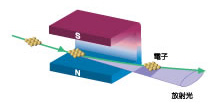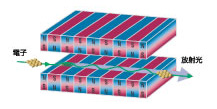
When high-energy electrons traveling at relativistic speeds (near the speed of light) are made to change direction, they emit electromagnetic radiation. Electrons forced to move along a circular path by a bending magnet undergo centripetal acceleration and emit strong radiation in a direction tangential to the path (Fig. 1). This is known as synchrotron radiation. With SPring-8 (a synchrotron facility with electron energy of 8 GeV), white synchrotron radiation can be obtained covering a broad range of wavelengths, from the far infrared through vacuum ultraviolet, soft x-rays, and x-rays, to gamma rays.
By inserting devices such as undulators (Fig. 2) and wigglers, composed of lines of magnets with alternating polarity, it is possible to make the electrons travel in a sinusoidal (zigzag) path. All of the synchrotron radiation generated as the electrons zigzag overlaps with the direction of travel, allowing the emission of very brilliant synchrotron radiation. With undulators in particular, the waves of the synchrotron radiation create interference, generating even more brilliant monochromatic (all with the same wavelength) synchrotron radiation at a specific wavelength.

- It can guide the electrons on the vertical axis but does not guide them on the horizontal axis.
- It produces “white” light with a broad range of wavelengths, from far infrared to x-rays.

- It focuses the light more sharply than a laser.
- It emits monochromatic light with high brilliance at a specific wavelength.







